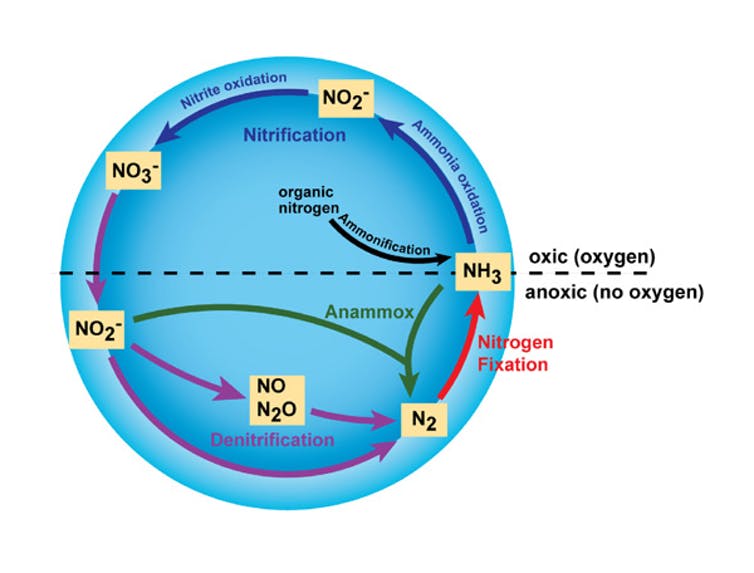An introduction to my MScCCAFS Research Project:
Advancing molecular understanding of Biological Nitrification Inhibition (BNI) for more climate smart agricultural systems.
For my Climate Change, Agriculture and Food Security (CCAFS) Masters’ thesis I have the opportunity to go to Columbia and work with CIAT (the International Center for Tropical Agriculture) on a very interesting subject: Biological Nitrification Inhibition (BNI).
At the broadest level, this project involves the intersection of a number of themes relevant to CCAFS: the importance of soil microorganisms, greenhouse gas emissions from agriculture, livestock management practices, plant physiology. Before elaborating on the concept of BNI and its potential for climate change mitigation, it is important to understand the process of nitrification and its impact on the environment.
The nitrification process and impacts in short:
The nitrification process involves different actors, including bacteria and archea which convert nitrogen into different forms
(see figure below). The chemical form of nitrogen determines how the compound is utilized, absorbed by plant roots or dispersed. In managed ecosystems, almost 70% of the applied nitrogen fertilizer is lost through nitrification or associated processes (Glass, 2003; Raun & Johnson, 1999). Nitrogen losses have significant impacts on the environment as it can result in nitric oxide (NO) and nitrous oxide (N2O) emissions or the leaching of nitrate (NO3)- in water.
Nitrous oxide gas is a powerful greenhouse gas that contributes to the global warming effect. NO is a reactive molecule which can take part in reactions that can destroy the ozone layer or contribute to acidification and eutrophication of ecosystems through the formation of acid rain. Nitrate leaching into freshwater bodies or groundwater can also lead to eutrophication and presents a health risk if consumed by human or animals (Giles, 2005).

This nitrogen loss is not only a major concern for environment but also increases inefficiency of N-fertilizer use and thus constitutes an economic loss for farmers (Coskun, Britto, Shi, & Kronzucker, 2017; Subbarao, Wang, Ito, Nakahara, & Berry, 2007).
A quick history of the discovery of BNI:
An early report by Russel in 1914 indicated that some field crops could influence nitrification and nitrate formation in soils. Later on, in 1951, another scientist suspected the existence of BNI. This scientist, Theron, suggested that some tropical grass roots were excreting substances that were toxic to nitrifying bacteria (Theron, 1951). In the following decades, several scientists supported that hypothesis, however the lack of proof of the direct effect of BNI hindered support from the scientific community (Moore & Waid, 1971; Rice, 1964). Finally, in 2006, a bioassay proved the direct inhibition of the nitrifying enzymatic pathways in Nitrosomas by the BNI activity of Brachiaria humidicola (Subbarao et al., 2006).
With the search for a sustainable, ecologically friendly and cost-effective solution to reduce the N loss from agricultural systems, studies of the regulation of nitrogen soil dynamics have increased and knowledge about BNI process and potential in crops has improved. Plants with the BNI trait release nitrification inhibitors which reduce or inhibit the nitrification of ammonia by nitrifier microorganisms. This not only limits potential nitrogen loss from agricultural systems but also keeps nitrogen in the soil; improving nitrogen recovery and uptake by the plants (Subbarao et al., 2006).
Brachiaria humidicola: a model plant for BNI
The major plant model for studying BNI in recent years has been Brachiaria humidicola, an important forage grass in tropical agricultural systems. CIAT possess a gene bank containing 601 accessions of Brachiaria spp. containing important agronomical traits such as the ability to grow on infertile soil or resistance to drought, that have been exploited in breeding programs (Keller-Grein, Maass, & Hanson, 1996). This, and their expertise in the topic of BNI, make CIAT an excellent place to study the mechanisms of BNI further.
The potential of Brachiaria for BNI could be promising in the pursuit of exploiting this trait to build climate smart agricultural systems. However, the BNI process must be better understood for its potential as a mitigation option in agricultural systems to be realised. The core mechanism of BNI is to inhibit the ammonia nitrification of surrounding nitrifiers, however we need to learn more about the influence of BNI on microbial communities.
My goal during the three next months is to advance the understanding of the effect of BNI on nitrifiers’ activity and community. Nitrifier community can be assessed by the present of genes contributing to denitrification in soil samples taken in Brachiaria humidicola fields, while the nitrifiers’ activity can be measured trough the expression of those genes within similar soil sample in comparison with samples taken where no specific BNI activity is known to be present. As of now, I have arrived at CIAT and have begun to devise a methodology to maximise the potential outcomes of my experiments.
